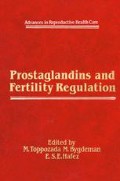Abstract
The metabolism of naturally occurring primary Prostaglandins was studied in several species during the 1960s. The investigations demonstrated that the metabolic degradation of these, biologically very potent, compounds was extremely rapid. The first step is an oxidation at carbon 15 in the Prostaglandin molecule leading to biologically inactive metabolites which are then further degraded. The half-life in the human circulation of primary Prostaglandins, e.g. PGE2 and PGF2α, has been estimated to be 5–10 s (cf. Samuelsson et al., 1975). The enzymes responsible for this rapid inactivation seem to appear in essentially all mammalian tissues (Samuelsson et al., 1975; Änggard et al., 1971). These studies led to efforts to synthesize Prostaglandin analogs where this oxidation at carbon 15 was blocked, which created compounds with a longer duration of biological action than the natural Prostaglandins.
Access this chapter
Tax calculation will be finalised at checkout
Purchases are for personal use only
Preview
Unable to display preview. Download preview PDF.
References
Änggard, E., Larsson, C. and Samuelsson, B. (1971). The distribution of 15-hydroxy-prostaglandin dehydrogenase and Prostaglandin-Δ13-reductase in different tissues of the swine. Acta Phys. Scand., 81, 396
Bergström, S., Gréen, K. and Bygdeman, M. (1976). Metabolism and pharmacokinetics of 15-methyl-PGF2α methyl ester after administration via various routes. Prostaglandins, Suppl. 12, 17
Bygdeman, M., Ganguli, A., Kinoshita, K., Lundström, V., Gréen, K. and Bergström, S. (1977). Development of a vaginal suppository suitable for single administration for interruption of second trimester pregnancy. Contraception, 15, 129
Dimov, V. and Gréen, K. (1983). ( To be published).
Dimov, V., Gréen, K., Bygdeman, M., Konishi, Y., Imaki, K. and Hayashi, M. (1983). Gas chromatographic-mass spectrometric quantitation of 16,16-dimethyl-trans-Δ2-PGE1. Prostaglandins (In press)
Granström, E. and Samuelsson, B. (1969). The structure of a urinary metabolite of Prostaglandin F2α in man. J. Am. Chem. Soc., 91, 3398
Gréen, K. and Bygdeman, M. (1976). Plasma levels of the methyl ester of 15-methyl-PGF2α in connection with intravenous and vaginal administration to the human. Prostaglandins, 11, 879
Gréen, K. and Bygdeman, M. (1977). Plasma levels of 15(S)15-methyl PGF2α following administration via various routes for induction of abortion. Prostaglandins, 14, 1013
Gréen, K., Bygdeman, M. and Bremme, K. (1978). Interruption of early first trimester pregnancies by single vaginal administration of 15-methyl-PGF2α methyl ester. Contraception, 18, 551
Gréen, K., Vesterqvist, O., Bygdeman, M. and Christensen, N. J. (1982). Plasma levels of 9-deoxo-16,16-dimethyl-9-methylene-PGE2 in connection with it’s development as an abortifacient. Prostaglandins, 24, 451
Hansson, G. and Granström, E. (1977). Metabolism of 15-methyl-prostaglandin-F2α in the Cynomolgus monkey and the human female. Biochem. Med., 18, 420
Miller, O. V. and Magee, W. E. (1974). In vitro hydrolysis of Prostaglandin F2α esters by serum or plasma of different animal species. Prostaglandins, 7, 29
Samuelsson, B., Granström, E., Gréen, K., Hamberg, M. and Hammarström, S. (1975). Prostaglandins. Ann. Rev. Biochem., 44, 669
Steffenrud, S. (1980). Metabolism of 16,16-dimethyl-prostaglandin E2 in the human female. Biochem. Med., 24, 274
Steffenrud, S. (1983). Metabolism of 9-deoxo-16,16-dimethyl-9-methylene-PGE2 in the human. Drug Metab. Disp., 11, 255
Editor information
Editors and Affiliations
Rights and permissions
Copyright information
© 1984 MTP Press Limited
About this chapter
Cite this chapter
Gréen, K. (1984). Metabolism and pharmacokinetics of prostaglandin analogs in man. In: Toppozada, M.K., Bygdeman, M., Hafez, E.S.E. (eds) Prostaglandins and Fertility Regulation. Advances in Reproductive Health Care, vol 4. Springer, Dordrecht. https://doi.org/10.1007/978-94-009-5600-1_2
Download citation
DOI: https://doi.org/10.1007/978-94-009-5600-1_2
Publisher Name: Springer, Dordrecht
Print ISBN: 978-94-010-8969-2
Online ISBN: 978-94-009-5600-1
eBook Packages: Springer Book Archive

